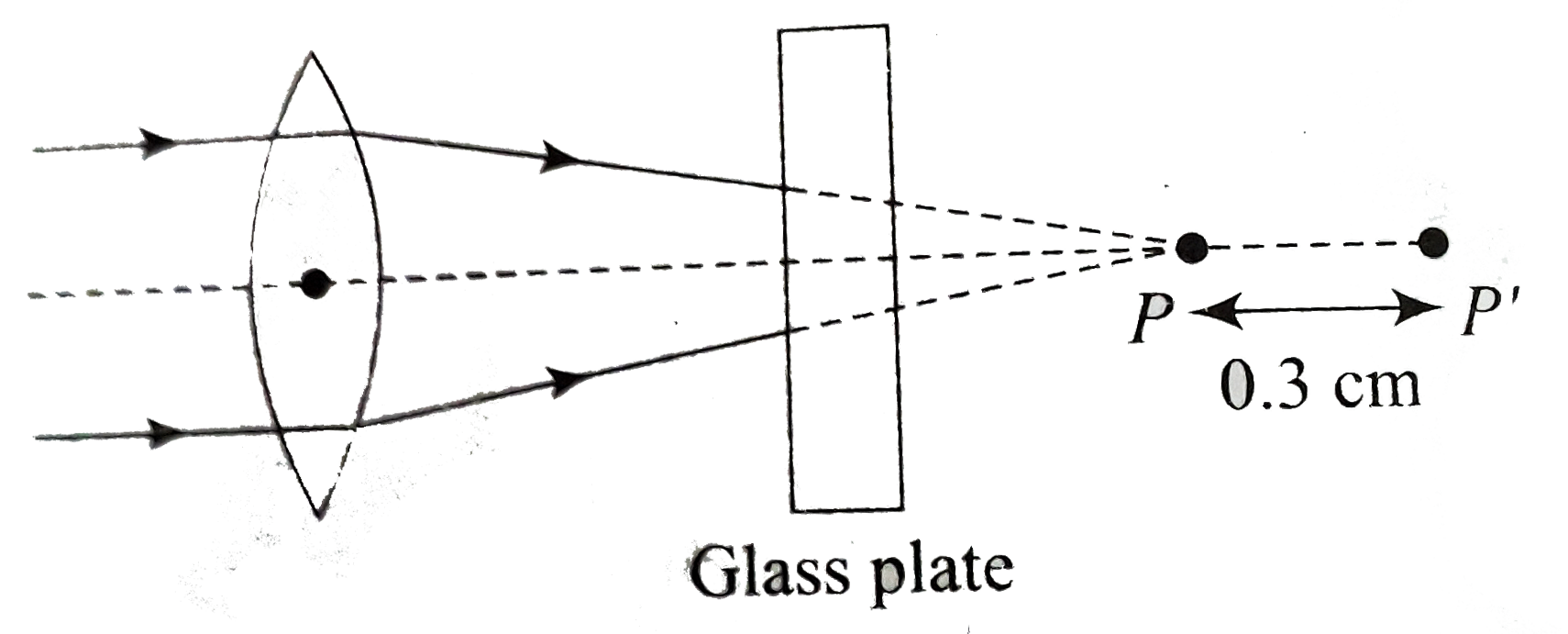Rays from a lens are converging toward a point P, a shown in Figure. How much thick glass plate having refractive index 1.6 must be located between the lens and point P, so that the image will be formed at P′?

0.8cm
1.6cm
5cm
2.4cm
The correct Answer is:A
Due to the insertion of glass plate, the image has to be shifted by 0.3cm.
Shift produced by a glass slab of thickness t and refractive index μ is given by (1−1μ).
So, t[1−11.6]=0.3⇒t=0.8cm
Topper's Solved these Questions
- BOOK - CENGAGE PHYSICSCHAPTER - GEOMETRICAL OPTICSEXERCISE - Assertion-Reasoninig2videos
GEOMETRICAL OPTICS
- BOOK - CENGAGE PHYSICSCHAPTER - GEOMETRICAL OPTICSEXERCISE - Linked Comprehension51videos
GEOMETRICAL OPTICS
- BOOK - CENGAGE PHYSICSCHAPTER - GEOMETRICAL OPTICSEXERCISE - Subjective26videos
GEOMETRICAL OPTICS
- BOOK - CENGAGE PHYSICSCHAPTER - FRICTIONEXERCISE - QUESTION BANK1videos
FRICTION
- BOOK - CENGAGE PHYSICSCHAPTER - GRAVITATIONEXERCISE - Question Bank39videos
GRAVITATION
Similar Questions
A point object is placed at a distance of 25cm from a convex lens. Its focal length is 22cm. A glass slab of refractive index 1.5 is inserted between the lens and the object, then the image is formed at infinity. Find the thickness of the glass slab (in cm).
View SolutionAn object 240 cm in front of a lens forms a sharp image on a screen 12 cm behind the lens. A glass slab 1 cm thick, having refractive index 1.50 is placed between the lens and the screen with its refracting faces perpendicular to the principal axis of the lens.
(a) By how much distance the object must be moved so as to again cast a sharp image on the screen?
(b) Another identical glass slab is interposed between the object and the lens. How much further the object shall be moved so as to form a sharp image on the screen.View Solution
Knowledge Check
- Question 1 - Select One
A point object is placed at a distance of 25 cm from a convex lens of focal length 20cm. If a glass slab of thickness t and refractive index 1.5 is inserted between the lens and the object, the image is formed at infinity. The thickness t is
A10cmB5cmC20cmD15cm - Question 2 - Select One
A point object is placed at a diatance of 25 cm from a convex lens of focal length 20 cm. If a glass slab of thickness t and refractive index 1.5 is inserted between the lens and the object, the image is formed at infinity. The thickness t is
A10 cmB5 cmC20 cmD15 cm - Question 3 - Select One
A converging lens forms a real image I on its optic axis. A rectangular galss slab of refractive index μ and thickness t is introduced between the lens and I. I will move
Aaway from the lens by (μ−1)Btowards the lens by t(μ−1)Caway from the lens by t(μ−1μ)Dtowards the lens by t(μ−1μ)
A point object is placed at a distance of25cmfrom a convex lens of focal length 20cm.If a glass slab of thicknesstand refractive index 1.5is inserted between the lens and object.The image is formed at infinity .Find the thickness?
View SolutionA point object is placed at a distance 25cm from a convex lens of focal length 20cm. If a glass slab of thickness t annd refractive index 1.5 is inserted between the lens and object, image is formed at . Thickness t is found to be K times of 5cm. Fink K.
View SolutionLocate the image of the point P as seen hy the eye in the figure
 View Solution
View SolutionFind the distance of object placed in the slab of refractive index μ from point P of the curved surface of radius R so that image is formed at infinity:
 View Solution
View SolutionA point object is placed at a distance of 25cm from a convex lens of focal length 20cm .If a glass slab of thickness t and refractive index 1.5 is inserted between the lens and object.The image is formed at infinity .Find the thickness?
View Solution

